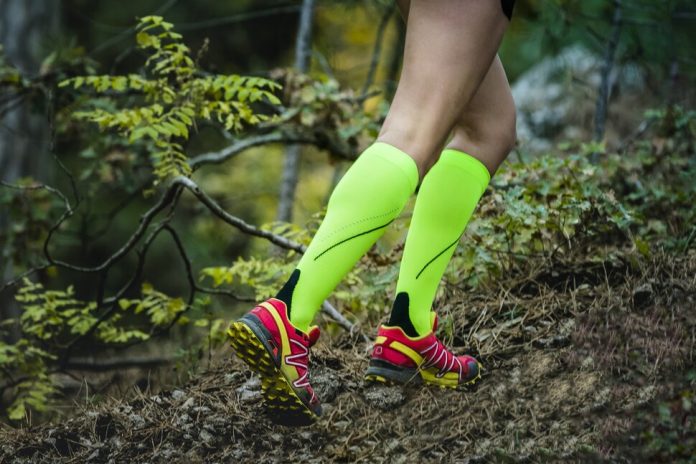Wondering if you should buy compression socks for your upcoming vacation? Read on to discover the benefits of compression socks for travel, some of the best options you can buy over the counter and more.
What are compression socks used for?
Compression socks apply pressure to your legs and feet, aiming to improve blood flow and prevent swelling. These tightly fitting garments have a range of uses: Your doctor may recommend compression socks or stockings for specific medical conditions, but almost anyone can use mild to moderate compression socks for everyday support and comfort. Compression legwear may offer particular benefits for health care workers, pregnant women, athletes, travelers and more.
What are the benefits of compression socks for travel?
You may have seen references to compression socks while reading up on travel tips, especially if you plan to fly to your destination. For some travelers, wearing compression socks can help during flights – when both inactivity and increased air pressure may cause discomfort or exacerbate medical conditions – as well as on long car rides and other methods of transportation. Here are some of the benefits of these specialized garments for travel.
-
Comfort: Any frequent flyer knows that sitting in cramped quarters for hours on end is not the most comfortable way to spend your day. As your veins try to work against gravity to keep your blood circulating, the blood can end up pooling in your legs, resulting in swelling, according to Dr. Ravi N. Ambani, M.D., MBA, in Cleveland, Ohio.
Compression socks may be able to help with that issue and improve your travel experience by imitating the effects of moving around even when you’re stuck stationary. “Movement and walking, even if for short bursts during a long flight, allows your calf muscles to contract and squeeze the blood in your veins back to your heart,” Ambani explains. “Compression therapy mimics this process to a degree leading to less swelling and leg fatigue.”
While Ambani points out that “there is not strong evidence to support the routine use of compression therapy for travelers” for nonmedical reasons, you may want to try them out to see if compression socks can make your time on transportation a little more comfortable (as long as you confer with a medical professional about any skin or circulation issues).
- Medical benefits: Doctors may recommend compression socks or other compression garments for travel for “patients with a history of deep venous thrombosis (DVT), venous insufficiency, or a hypercoagulable disorder,” Ambani says. Likewise, Adrian S. Banning, a certified physician assistant with a doctorate of health science and an associate professor at Delaware Valley University, says a 2021 Cochrane study shows “good evidence to suggest that wearing compression stockings on a flight of at least four hours does reduce the chances of DVT” among other particular medical benefits.
What are the different types of compression garments?
You may encounter the term “graduated” in your search for compression socks. Rather than applying uniform pressure, graduated compression socks use a gradient, so the tightness of the garment varies along your leg. “The sock has a higher pressure farthest away from the heart and that pressure decreases as we travel up the leg,” Ambani says. “By creating a gradient of pressure the compression sock helps to return fluid back to the heart where it can be recirculated.” Since graduated compression socks give your lower legs the most support, they can be helpful on flights and other situations where your veins have to contend with gravity.
Another distinction is compression socks versus compression stockings or tights. “Compression socks and stockings are very similar products in that they are designed to provide measured pressure to the lower extremities,” Ambani says. “Both socks and stockings can apply the same amount of compression, so the real difference lies in the material that they are constructed with and length.” The stockings can go as far up as your thigh, while nonmedical compression socks usually go no higher than your knees.
Compression socks also come in varying levels of compression, so you’ll need to select a compression level before you make your sock purchase.
What level of compression do you need?
A compression level of 15-20 mmHg is the most popular for travel; anything higher than 20 mmHg crosses into medical-grade territory and should not be purchased without consulting your doctor. But even if you’re not seeking a high level of compression, Banning recommends speaking to your health care professional to find out what level would best suit your needs. “If the compression stockings are too uncomfortable to wear and so you don’t wear them at all or if you wear them incorrectly, you won’t get any benefit at all or you could possibly have side effects,” she notes, citing a 2014 study.
Incorrect usage or excessive tightness can cause possible side effects such as skin damage or irritation – “especially for people with thin skin, like the elderly,” Banning says. Check with your doctor for advice based on your medical history, especially if you feel you need medical-grade compression socks.
What size compression socks do you need?
Once you have chosen what level of compression you need, you need to determine the size – be aware that sock sizing will vary by brand. Some companies will have typical small, medium and large socks, while others may go by calf size or other specific measurements. It’s important to check the brand’s size guide before making your purchase, so you know you are getting the correct size.
How to use compression socks when traveling
You may be wondering when to put on your compression socks before your flight and how long you can wear them. “You should wear them as long as you can tolerate,” Ambani says. “In an ideal scenario, you would put them on first thing in the morning when your legs are the least swollen, keep them on during your entire travel, try to walk around at least once an hour, and take them off after arriving at your final destination.”
You’ll have to determine for yourself – ideally in advance of any major travel plans – how long you can tolerate wearing your compression socks. Keep in mind that you may have difficulty putting them on or taking them off within the confines of your airplane seat, so familiarize yourself with the compression socks beforehand and plan accordingly.
The Best Compression Socks for Travel
(Note: Prices and availability were accurate at the time of publication; they may fluctuate due to supply chain issues.)
Sockwell Women’s Full Flattery Moderate Graduated Compression Socks
(Courtesy of Sockwell)
Compression level: 15-20 mmHg
The ultralight cushion sole of these Merino wool socks will make whizzing through the airport a breeze. The moderate level of graduated compression, seamless toe closure and spandex throughout the socks all add to your comfort. Users appreciate the wide calf, saying this can be a good option for those with larger calves who find other compression socks painful.
[Sockwell Women’s Full Flattery Moderate Graduated Compression Socks: $29.99 or less. View deal.]
Travelsox TS1000 Original Travel Graduated Compression Socks
Compression level: 10-18 mmHg
Travelsox has designed compression socks specifically for travel. The company uses patented compression technology intended to stimulate circulation and ease swelling when you have to spend a long time in close quarters, making these socks potentially beneficial for your next long-haul flight. The Coolmax material provides superior moisture wicking and comfort. Recent buyers were impressed with the quality and the way these socks helped their legs on airplanes and in other cramped spaces.
[Travelsox TS1000 Original Travel Graduated Compression Socks: $29.99 or less. View deal.]
Bombas Everyday Compression Socks
Compression level: 15-20 mmHg
These medium-level compression socks feature a seamless toe and a design that cradles the arch of your foot to give you the support you need. This product is also made with extra-durable cotton yarn for resisting wear and tear. As a bonus, for every pair of socks bought, Bombas donates one pair of socks to homeless shelters. Wearers of these compression socks love how comfortable they are.
[Bombas Everyday Compression Socks: $28 or less. View deal.]
Comrad Knee-High Compression Socks

(Courtesy of Comrad Socks)
Compression level: 15-20 mmHg
Comrad’s compression garments are lab-tested with Swisslastic MST Compression Devices, providing you with a moderate level of support and compression for your next flight. These knee-high nylon socks are moisture-wicking and made with thin, breathable fibers fitted to your leg, as well as a silver antimicrobial that eliminates odor. Travelers love how easy they are to put on and note that these compression socks are comfortable to wear.
[Comrad Knee-High Compression Socks: $28 or less. View deal.]
CHARMKING Compression Socks for Women & Men
Compression level: 15-20 mmHg
These knee-high compression socks come in packs of eight, so you won’t have to worry about losing a pair before a big trip. With these socks available in a wide variety of solid colors and fun patterns, you’ll be able to make a fashion statement while staying comfortable on the plane. These graduated compression socks have a no-slip cuff, reinforced heel and toe, ankle protection and moisture-wicking fabric so you stay dry. Travelers praise the quality of compression you get for an affordable price.
[CHARMKING Compression Socks for Women & Men: $26.99 or less for eight pairs. View deal.]
+MD 3 Pairs Bamboo Compression Socks
Compression level: 8-15 mmHg
These knee-high compression socks offer a lower grade of graduated compression, which could make them a good option for travelers seeking just a little extra support, and particularly those who plan to spend a lot of time on their feet. Made with bamboo fiber and polyester, these +MD socks are moisture-wicking to keep your legs dry and have a nonslip cuff and cushioned heel. These garments come in a pack of three – set aside one to wear, a spare for your carry-on and a pair for the flight home. Recent users appreciate how comfortable they are, saying they are able to wear them all day long.
[+MD 3 Pairs Bamboo Compression Socks: $15.99 or less for three pairs. View deal.]
VIM & VIGR Moisture Wick Nylon Graduated Compression Socks

(Courtesy of VIM & VIGR)
Compression level: 15-20 mmHg
Made with moisture-wicking nylon, these compression socks are breathable and apply graduated pressure for increased circulation, so you won’t have to worry about swelling. VIM & VIGR’s legwear, which is listed with the FDA, was developed in partnership with vascular surgeons and vein clinics, so you know you will be getting a quality product. Users say they appreciate how they no longer had their usual swelling after a flight when wearing these socks.
[VIM & VIGR Moisture Wick Nylon Graduated Compression Socks: $38 or less. View deal.]
Pembrook Women’s Compression Socks
Compression level: 8-15 mmHg
These Pembrook compression socks come in a six-pack of fun, bright colors to make you smile as you pull them on before your flight. The mild graduated compression up to your knee and breathable cotton-polyester blend are designed for top-notch comfort and function. These compression socks are machine-washable, so you don’t have to worry about any extra care for them. Reviewers compliment the quality for the price and the comfortable compression these provide.
[Pembrook Women’s Compression Socks: $29.95 or less for six pairs. View deal.]
Bropite Open Toe Compression Socks
Compression level: 15-20 mmHg
These open-toe compression socks are a top option for those who don’t want a full sock; the toeless design will allow you to get all of the benefits of a regular compression sock without scrunching up your toes. Other features include a breathable fabric, a reinforced heel for durability and a moderate level of graduated compression. These Bropite socks come in packs of two, and recent wearers call them well made and effective.
[Bropite Open Toe Compression Socks: $16.99 or less for two pairs. View deal.]
Medical-grade compression socks
While compression socks at a level of 20 mmHg or less may work well as nonmedical support for most flights and other aspects of your everyday life, if you have a history of DVT or other medical issues, your doctor may prescribe you a higher compression level. If you have received specifications from a medical practitioner and are looking for 20-30 mmHg compression socks, here are some top options:













